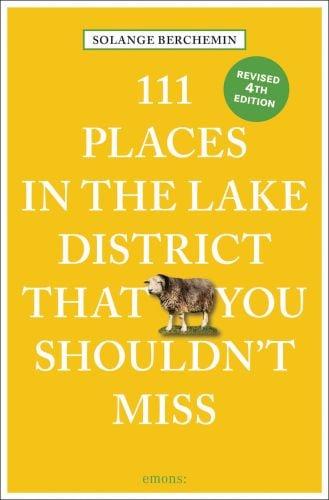

Schwitters at the Armitt
Dada in Cumbria
The Armitt is a fascinating museum, gallery and library. Since it is located in the heart of the Lake District, in the town of Ambleside, it would be natural for visitors to expect only works by local artists. For that reason, several rooms devoted to the German Dadaist Kurt Schwitters come as a surprise. In fact, the permanent collection here houses the largest number of works by this artist, one of the 20th-century greats.
Kurt Schwitters was best known for his collages, harbingers of pop art. Born in Hanover in 1887, in his early years Schwitters experimented with several genres and media: Cubism, Expressionism, Dadaism, Constructivism to name but a few. In 1937, he fled Nazi Germany, narrowly escaping arrest by the Gestapo. On hearing about the concentration camps, Schwitters renounced his German nationality. From then on, he refused to speak a word of German and fled first to Norway, then to Great Britain where he was interned for over a year. On release, with his health declining, he moved to rural Cumbria. Ambleside must have looked like a strange and rustic town to the artist, but it inspired simultaneously some of his most conventional and his most avant-garde works. In the hope of making a living whilst in Ambleside, he painted portraits, flowers and landscapes in a traditional manner to appeal to the tourists and the wealthy locals. Thirty of his paintings and pencil drawings can be seen at the Armitt Museum, including a striking 1945 painting of the Bridge House.
Schwitters’ most influential work was his Merz Barns, installations in barns containing 3D abstract collages made out of all sorts of discarded and broken items. There is very little left of his Lake District barn, in Elterwater, unfinished at his death in 1948, but the Armitt Museum collection includes one of his collages called Wood on Wood.


Address Rydal Road, Ambleside, LA22 9BL | Getting there From the south, follow A 591, pass the Bridge House, cross the mini-roundabout, take the first right turn. From the north, follow A 591 past Green Bank Road, take the left turn just before the mini-roundabout. Bus 555 and 599 will take you to Ambleside, Keswick or Lancaster. The pay-and-display car park is opposite the museum. | Hours Tue – Sat 10.30am – 4.30pm | Tip Schwitters is buried in St Mary’s Church in Ambleside. His grave is marked with one of his sculptures, Die Herbstzeilose.
St Bega’s Church
It beggars belief
Bega lived in the 7th century. Or in the 9th. Or did she live at all? The story goes that she was the daughter of an Irish chieftain, and her family wanted to marry her off to a Viking prince. In order to preserve her virginity, she fled across the Irish Sea with her only possession, an arm-ring gifted to her by an angel. She landed on the English shore at St Bees, upon which the priory was founded in her honour. Whether due to Chinese whispers or miracles performed by her or her blessed bracelet, her cult endured through the millennia.
The church of St Bega, on the shore of Bassenthwaite Lake in the middle of fields, has far-reaching views of Broom Fell. Bega wanted to build a convent in a safe place, and God told her to build it on the only place that didn’t have any snow. It doesn’t need snow for this small, isolated church to be amazingly peaceful and tranquil. It’s one of the few churches in the country that predates the first millennium and is still in use for regular services and weddings, having been restored and added to for another millennium after its construction circa 950. The large stones of its walls are a slight mystery. Are they from Roman times? If so, was the church erected on an earlier building?
Details of note are the 14th-century baptismal font, the Norman chancel arch and the prayer-story of St Bega on the north window sill. There are also simple but beautiful objects – a medieval lead crucifix and a wrought-iron hourglass used to time sermons. The main door catch is a work of art. Various local families are remembered in the stained-glass windows. Attachment and loyalty are a key concept here; the coat of arms of George II over the archway reminded people of their link to the English crown during the 1745 rebellion. There was more, but the Victorian restorations erased earlier evidence of how this little church crossed the centuries.


Address 6 The Orchard, Bassenthwaite, CA12 4QS | Getting there There is a pay-anddisplay car park at Dodd Wood on A 591. From there the church is an easy 10-minute walk by the left side of Mirehouse gardens via a public footpath and across the field. Access by car is possible, if necessary, within 50 yards of the church, down a field track with several gates to shut and open. | Hours Always open, services twice a month, bibles in 30 languages | Tip St Kentigern’s at Crosthwaite is another fascinating 12th-century church, which contains a complete set of Tudor consecration crosses, nine inside and three outside. It is signposted off the B 5289 (High Hill) near Keswick (www.crosthwaitechurchkeswick.co.uk).
The Bluebird Wing
A passion for speed
The Bluebird Wing at the Ruskin Museum in Coniston is a tribute to the local hero and speed record-breaker, Donald Campbell. In the Fifties and Sixties, Campbell’s eight world speed records captured the imagination of a whole generation. In 1964, he achieved a double record: 276mph on water and 403mph on land. Campbell was 45 when he died on Coniston Water, on 4 January, 1967. After a first attempt, when his famous hydroplane, Bluebird K 7, almost reached the target of 300mph, Campbell tried once more. It was an attempt too far. At an estimated 320mph, Bluebird K 7 went into a somersault and sank. Thirty-four years later, the hydroplane wreckage and Donald Campbell’s remains were retrieved from the lake bed by diver Bill Smith and his team.
The team set out to restore the boat, and is using as much material from the original wreckage as possible. Each newly repaired part is placed on a life-size footprint of the hydroplane, in an airy room filled with natural light. One day, the completely restored hydroplane will be on display. To complete this very special tribute, there are cabinets with photographs of Campbell and mementoes such as his crash helmet.
The Ruskin Museum is owned and managed by the people of Coniston. It is built strictly on Ruskinian principles of loyalty to local materials. Slate, copper and Coniston stone were the only materials used. The buildings are low and fit in perfectly with the surroundings. In the old building, the museum celebrates John Ruskin’s life. A series of rooms are crammed full of Ruskin’s delicate watercolours, enchanting sketchbooks and musical instruments. Each room offers a good depiction of this leading Victorian art critic and social thinker. There is also a small room dedicated to Arthur Ransome, journalist and author, best known for his Swallows and Amazonsseries of children’s adventure books.
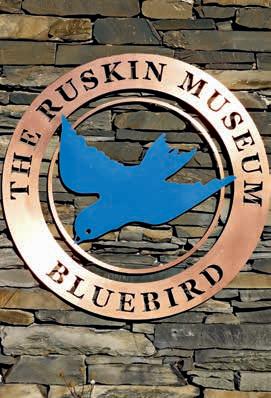

Address Yewdale Road, Coniston, LA21 8DU, +44 (0)1539 441164, www.ruskinmuseum.com, information@ruskinmuseum.com | Getting there Coniston is a small village, with a main pay-and-display car park in the centre. There are buses to and through Coniston: Coniston Rambler 505 from Ambleside and Hawkshead, and X 12 from Ulverston. The Cross Lakes Experience runs a boat / coach circuit from April to November from Windermere to Coniston. | Hours Tue – Sun 10.30am – 3.30pm | Tip Ruskin’s grave in the local churchyard is marked by a remarkably large, carved cross.
Grizedale Forest
Giants, Ancient Foresters and Clockwork Forest
Grizedale Forest is 2,000 hectares of woodland, owned by the Forestry Commission. This is a forest for art, adventure, nature and families. There is walking, mountain biking, cycling, Segway trails, and many works of art. Visitors can fly through the trees on a zip wire, and orienteering courses of various lengths are available. The visitor centre is easy to spot with its large welcome banner, and indeed a warm welcome is given to all.
Each walking route is colour coded. Some are low-level such as the yellow low-level Millwood Trail, a short loop on a gravelsurfaced path, or the blue Ridding Wood Trail, which goes past some unusual and ornate trees. The Silurian Way is the ultimate ten-mile Grizedale walk. The trail is named after the geological time period during which the forest’s characteristic grey slates were formed. The walk is categorised as ‘strenuous’, and it includes the Carron Crag, the highest point in the forest at 314 metres, with spectacular views. The walk passes most of the sculptures that populate the forest.
Indeed, Grizedale is famous for featuring the largest collection of site-specific artwork in the UK, the result of a collaboration between the Grizedale Society (now Grizedale Arts) and the Forestry Commission, begun in 1977. Sculptors of international renown, such as David Nash, have been included. There is no specific sculpture trail. Instead, works of art are found along the various walks. Embark on the pink Bogle Crag trail to take in Andy Goldsworthy’s iconic Taking a wall for a walk.Each piece of art is in symbiosis with the environment and makes use of the natural surroundings. Most are carved out of wood, stone or other natural materials but not all. Some of the trail markers may be obscured by vegetation so a bit of forward planning could go a long way. Maps are available at the visitor centre, or downloadable for free.
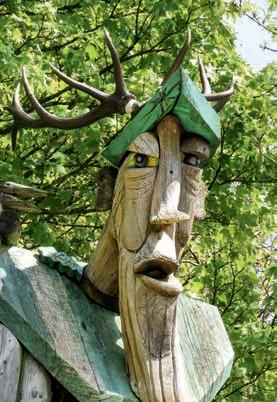

Address Hawkshead, Ambleside, LA22 0QJ, +44 (0)300 067 4495, www.forestryengland.uk/ grizedale, grizedale@forestryengland.uk | Getting there From the south, follow B 5286 till 2 miles after Hawkshead, then take first right and follow brown tourist signs. From the north, take A 591 to Ambleside, follow the direction to Langdale / Coniston, take B 5286 to Hawkshead then follow the signs. Parking for a fee on site. | Hours Visitor Centre & Forest Café, daily 10am – 4pm, summer 10am – 5pm | Tip If you love forest walks and mountain biking, another great destination is Whinlatter Forest (see ch. 106).
Little Salkeld Watermill
Not run-of-the-mill
‘Once upon a time there was a miller who lived with his wife in great contentment… ‘ The Grimms Brothers’ words spring to mind when setting eyes on this charming watermill with its baby-pink walls and blue windows and doors, set in a peaceful atmosphere overlooking Sunnygill Beck next to the lovely village of Little Salkeld in the charming Eden Valley. Though some of the village’s records go as far back as 1292, the watermill doesn’t appear until the 18th century, when the Scottish army eventually left the area and the local population looked more serenely towards a peaceful future. At first, it was a small local affair. Farmers arrived with their sacks of grain to be milled. They lined up their horses and carts on the dirt road still in existence in front of the mill. Since that time, the mill has prospered only to have reversals of fortune, mirroring the ups and downs of the area. In the 1940s, when it was producing oatmeal, it ground to a halt. In 1974, the watermill was purchased and the historic wheels started grinding again.
It’s one of the few mills in the UK that specialises in homegrown organic and biodynamic (BD) grains. The milling process is explained during tours where visitors can hear the miller’s stories and the mill’s history along with tales of the past and present village life. Bread-making courses are offered to budding and / or fully fledged bakers. There is a mill shop where visitors can buy the mill’s flours, from their Harvest Flour created to be used in bread machines to a Special Blend ‘invented’ for vegans and vegetarians, and many more speciality flours.
Next door, there is an award-winning tearoom with two rooms serving delicious wholefood, vegetarian dishes and very nice scones. The tearoom is a welcome stop at the end of the walking circuit taking in Maughanby Circle (see ch. 67) and Lacy’s Caves (see ch. 65).
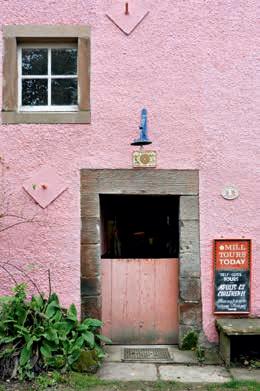

Address Little Salkeld, CA10 1NN, +44 (0)1768 881523, www.organicmill.co.uk | Getting there The mill is on the C2C Cycle Route. By car or bicycle, from M 6 exit at J 40, follow A 66 East, take A 686 to Alston. After 6 miles turn left at Langwathby and follow for 1.5 miles. | Hours Mon, Tue, Thu – Sun 10.30am – 4pm | Tip There are only a handful of corn mills dotted around the Lake District. Heron Mill in Beetham is an 18th-century watermill, open Wed – Sun 11am – 4pm throughout the year (www.heronmill.org).
Fish Cross
Something fishy on top
Archaeological evidence shows that there have been inhabitants on the site of Pooley Bridge village since Roman times. It is even said that the area was populated before the Roman conquest. The name derives from the pool where the river meets the lake and where there was a primitive crossing.
Since the first millennium and throughout the centuries, fish has been an important part of the local industry. In the 12th century, a market charter was granted for the weekly sale of fish, in the market square. The latter was marked by a cross monument with a fish and a weather vane similar to the one you see today. Fish traps were in place between the river and the lake by the 18th-century bridge. Sadly, the bridge is no more; it was swept away by the 2015 floods. At the end of the 18th century the census records 237 inhabitants in Pooley. With the growth of tourism, however, the cross was seen as a traffic impediment, so it was removed in 1859 to make way for turning stagecoaches.
Wanting to mark the arrival of the 21st century, the Barton Parish Council, after a fair bit of controversy, settled on a monument that would commemorate the granting of the charter and highlight the village’s fishing connections. The Millennium monument designed by James Banks stands in Crown Square. It is a four-metre-high, pink sandstone column and incorporates Pooley Bridge history. It’s also a reminder that in the past there was a cross here in Pooley. The tall pedestal is situated on Crown Square, topped with a two-metre obelisk on which a silver metal weathervane sits. There is a silver fish on top. The Coats of Arms of the Dacres and Hasells of Dalemain families are etched on two of the monument faces. This is in recognition of the historical role both families played in the area. Bizarrely, because of its height, the silver fish at the top can often go unnoticed.
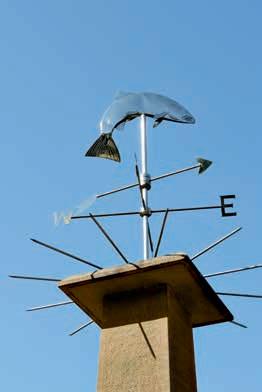

Address Crown Square, Pooley Bridge, CA10 2NW | Getting there By car, from A 66 take A 592 and B 5320. There is a car park in the village, on the right just after the bridge, and a row of parking spaces on the left by the Fish Cross; bus 508 from Windermere to Penrith stops at the Crown Hotel. | Access Year-round | Tip Just outside Pooley Bridge, at the junction between Penrith and Tirrel, is an unusual fingerpost with a crown on the top. This unusual finial for a road sign is painted in bright red, white, blue and green, a jolly addition to an otherwise bland direction post.
Tarn Hows
Mirror, mirror, which is the fairest of them all?
If you were asked to draw a picture of an idyllic tarn (small mountain lake), you might come up with something closely resembling Tarn Hows. Situated between the villages of Coniston and Hawkshead, it has often been described as the perfect tarn. Tarn Hows is man-made, which explains its beautiful proportions. Originally, it was three small tarns, rather unimaginatively called High Tarn, Low Tarn and Middle Tarn. Until 1862, the area was a part of the open common grazing of Hawshead parish. In his guidebook to the Lakes, Wordsworth mentions the area but doesn’t pay any heed to the tarns. It didn’t get much better 50 years later when another writer, G. D. Abraham, described Tarn Hows simply as, ‘Set wildly among larches and heather slopes.’
Much has changed since then thanks to James Marshall, Member of Parliament for Leeds and owner of the land, who embarked on a series of landscape improvements. The surroundings, footpaths and picnic areas were carefully designed for maximum impact. The woodland plantations were expanded. Spruce, larch and pine trees were planted around the tarn. When in 1930 the Marshall family sold 4,000 acres to Beatrix Potter for £15,000, it was already a famous beauty spot. She, in turn, sold half to the National Trust, which is still managing it to this day, and bequeathed them the other half.
Tarn Hows is at its best on a bright clear day when the Langdale Pikes to the north and the mighty Helvellyn make for a dramatic background. The surface of the lake is like a blue mirror and reflects the mountains. Keep an eye out for red squirrels and, between March and October – the ice-cream van! The 1.5-mile, pushchair- and wheelchair-friendly path around the tarn makes for a nice family walk. Though it can be packed with people walking and picnicking in the summer, its unique charm means it’s not to be missed.
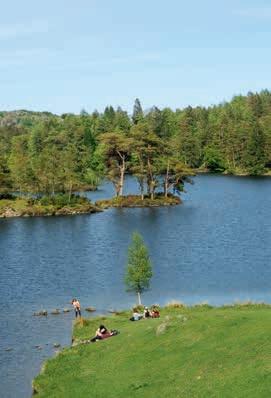

Address Tarn Hows, LA21 8DP | Getting there From B 5285 turn onto the minor road running between Hawkshead and Coniston. Tarn Hows is 1 mile from the junction and clearly indicated, with a large National Trust car park. Bus 505 operates between Coniston and Hawkshead, stopping at Hawkshead Hill, a roughly 1-mile walk away, generally uphill. The tarn can be reached on foot from either Hawskhead (1.5 miles) or Coniston (2.1 miles), one of the loveliest parts of the Cumbrian Way. | Access Year-round | Tip There is plenty to do around Tarn Hows. Perhaps take a cruise in the beautiful steam yacht Gondola on Coniston Water and hear all about the area (www.nationaltrust.org.uk/steam-yacht-gondola).
Start of the Cumbrian Way
Sit on a compass bench or a squirrel bench
From April to October, it’s possible to walk the 119km Cumbrian Way, which cuts through the Lake District National Park from south to north, starting at the market town of Ulverston and finishing in the city of Carlisle, or vice versa. The start of the Cumbrian Way in Ulverston is marked by a sculpture of a compass with a cairn of rocks in its centre. The rocks are representative of the area’s geology, which is shown on the side of the cairn together with an Ordnance Survey map referencing key points along the route. The sculpture was installed in February 2002 and is the work of sculptor Chris Brammall, whose studio sits at the edge of the Lake District National Park. If this impressive multimedia piece of art is striking, it’s got competition in an iconic, colourful, cast-iron ‘squirrel bench’ by the stone bridge over the Gill. The metal squirrel seats were originally donated by GlaxoSmithKline on the 50th anniversary of the company. There are 50 such benches dotted around Ulverston. These public seats are slatted wooden seats with sides decorated with the Furness Railway’s bench design, a cast-iron bushy-tailed red squirrel munching on a purple bunch of grapes, hanging from a blue vine. The long, slender stem of each metal plant creeps and trails, winding itself up and down to form the metal sides of the benches.
The Cumbrian Way was developed in the 1970s. This popular walk takes in the natural beauty of the Lake District. While it is a low-level walk, the route has significant inclines and a rugged terrain requiring a certain level of fitness. Along the way, the tarns and boggy areas provide a habitat for carnivorous plants including sundew and butterwort. Crossing woodlands, there might be opportunities to spot a few real red squirrels; however, it’s a much safer bet to take a few pictures of the ‘squirrel bench’ at the start of the hike.
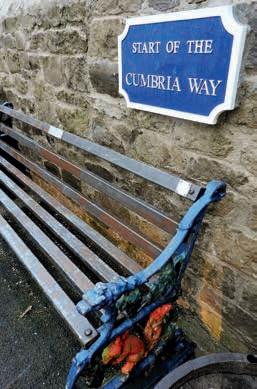

Address At the far end of The Gill car park, Unnamed Road, Ulverston, LA12 7BN |
Getting there The Gill car park is situated west of Ulverston. Take Stanley Street until you can go no further; the car park is on your right. | Access Year-round | Tip To see more examples of Victorian wrought iron, head east along the A 590 to Grange-over-Sands station where the metalwork has been restored to its former glory.
RB Woodall
Cumberland sausages don’t fear the Wurst
Something delicious has been happening for nearly 200 years at the western edge of Lakeland, in the hamlet of Waberthwaite. Something which has not passed unnoticed, and was even spotted by the Duke of Edinburgh. As HRH Prince Philip visited a trade fair in Penrith, he tasted Woodall’s products. So smitten by their Cumberland sausages was he that the royal household bestowed them the highest seal of approval: a royal warrant, originally for sausages, now for bacon. The plaque marking the event is proudly displayed on the frontage of the shop-cum-post office, which doesn’t appear to have altered much since Victorian times. Like many ventures in these parts of the country, it all started back in the 1800s, with an impoverished widow in need of extra income. When her husband died, Mrs Hannah Woodall began curing meat using local pigs, salt, sugar and saltpetre. The business still operates on the same principles, run now by the seventh, eighth and ninth generations of the Woodall family.
Some speculate that Cumberland sausage originated with German miners who came to Cumbria in the 1500s to work. While most pork bangers on the market are made with 60% meat, it may come as a surprise that RB Woodall’s Cumberland sausages contain 98% pork shoulder and belly. Of course, everything is down to the spicing – pepper, mace and nutmeg enter in the composition, but the rest is a trade secret. The Woodalls are tight-lipped about the exact mixture. They are only prepared to reveal that the secret is kept by one member of the family at any time. There is one thing we know for certain: a Cumberland sausage is a continuous coil. At RB Woodall, coils in the main weigh 500g each. Cumberland sausages can be as long as the natural skin allows. RB Woodall goods are sold on the premises, delivered locally or by mail order and can’t be found in supermarkets.


Address Lane End, Waberthwaite, near Millom, LA19 5YJ, +44 (0)1229 717237 or +44 (0)1229 717386, www.rbwoodall.co.uk, mail@rbwoodall.com | Getting there Waberthwaite is 2 miles south-east of Ravenglass. By car, from A 595 enter the hamlet of Waberthwaite, turn down past the school, the shop is on the right. | Hours Mon – Fri 8.30am – 12:45pm & 1.15 – 5pm, Sat 8.30am – noon | Tip Cumberland food, unlike any other regional food in England, is spicy. This is because in the 18th century, all sorts of tropical spices landed in Whitehaven (see ch. 39 for Grasmere Gingerbread).
Lakeland – the Store
A Lake District success story
Lakeland, the home-shopping pioneers, has a special place in the heart of the nation. It has been going strong for over half a century without fighting unnecessary wars with its competitors. From the beginning, this family firm focused on its customers’ needs, a principle reflected in their Windermere flagship store. The modernist glass building with its easy-to-navigate shop, natural light and fresh candy colours, offers a delightful shopping experience. On the openplan ground floor, there is a state-of-the-art kitchen where visitors can watch demonstrations and try out the newest gadgets. The aisles are spacious and products easy to find. A visit wouldn’t be complete without trying out Steven and Maj Doherty’s dishes in the first-floor café. Steven was the first British chef to head a three-Michelin-Star establishment.
Lakeland’s motto could be the founder’s guiding principle: ‘We take care of our customers and the business takes care of itself.’ The story began with the humble plastic bags that Alan Rayner used to wrap chickens in on market days. When home freezing became the next new thing, the company offered freezing and storing equipment. By then their mail order was very popular. The next step was a watershed in the firm’s history, as Sam Rayner explains in their golden anniversary celebration book: ‘In a moment of inspiration, we got a glimpse of what must seem blindingly obvious to anyone now: people who froze food also cook it.’ Soon the demand for cooking equipment outweighed everything else.
The operations are now a far cry from the days when the Rayner brothers used to wheel parcels to the local post office on a trolley for pocket money but, in the words of Wendy Miranda, Lakeland’s Customer Ambassador, ‘Some things have never altered such as the warm family feeling and the brothers’ genuine care for their staff and customers.’
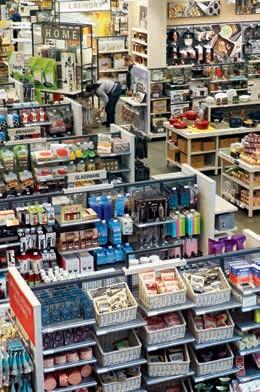

Address Alexandra Buildings, Windermere, LA23 1BQ, +44 (0)1539 488100, www.lakeland.co.uk | Getting there Next to Windermere railway and coach station. By car, approach Windermere on A 591 and follow the signs for the railway station; free parking on site. | Hours Mon – Fri 8am – 7pm, Sat 9am – 6pm, Sun 11am – 5pm | Tip Next to Lakeland is another retailing success story in the north of England: Booths. The chain focuses on regional produce with specialist fish, meat and deli departments.
Acknowledgements
It’s impossible to write a book like this alone, and I could not have done it without the following people: Simon for his invaluable support, Claire for her warmth and marmalade, Alison who worked tirelessly editing this book, every single person who showed me around, gifted me their time. You are too many for me to name each one, but you know who you are. Thank you so much.

Solange Berchemin was 18 when she travelled solo to the other side of the world, four years later, her partner took her to visit the Lake District. It was love at first sight. She has always enjoyed words and has a passion for people’s stories. If there is a story somewhere she will find it. Ten years ago, after an atypical career path which led her to pick cotton in Greece and manage the largest languages department in London (not at the same time), she turned to writing. Columnist for the Greenwich Visitor, her articles have appeared in national and international publications such as The Toronto Star, BBC Good Food, The Sunday Times. She writes a blog and is the author of five books but when it gets too much she returns to the Lakes to collect more stories. To read her complete biography go to www.solangeberchemin.com.
The information in this book was accurate at the time of publication, but it can change at any time. Please confirm the details for the places you’re planning to visit before you head out on your adventures.
